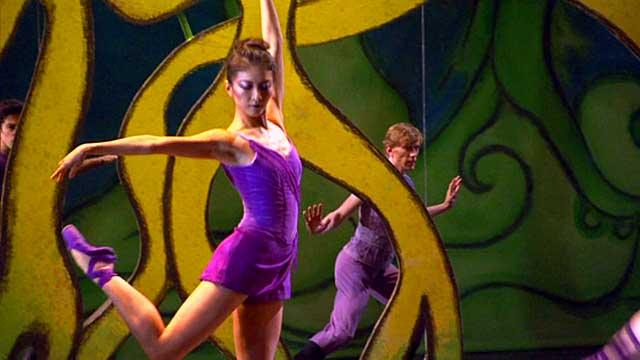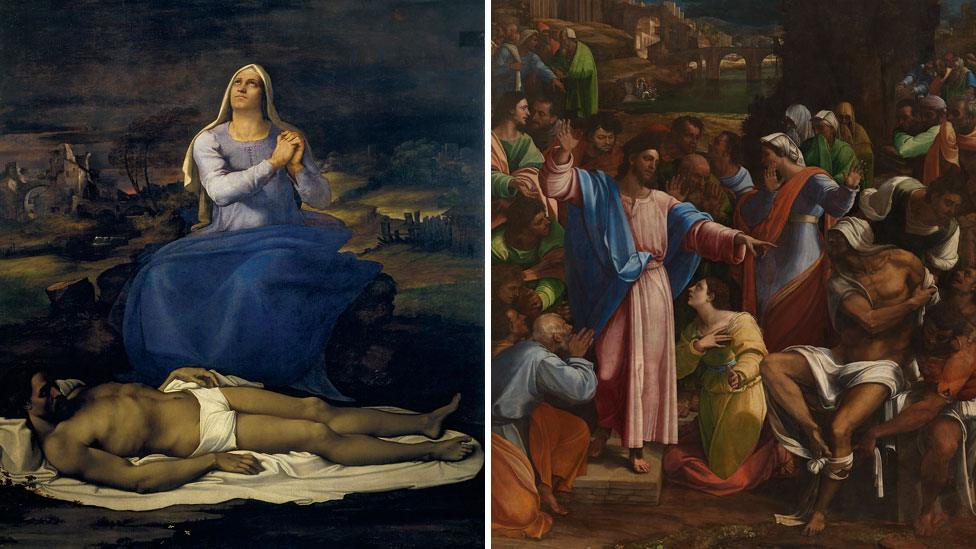Chris Ofili is weaving magic
- Published

Chris Ofili's tapestry took three years to create
I know some folk think Chris Ofili has gone off the boil since his Turner Prize-winning heyday, when he was considered one of Charles Saatchi's gang of Young British Artists.
Back then, Ofili incorporated elephant dung and cut-outs from porn mags in his paintings, which upset Mayor Giuliani considerably (and the current President who called Ofili's painting, Holy Virgin Mary, "absolutely gross") when Saatchi took his Sensation show to NYC in 1999.
Nowadays, the Mancunian artist lives and works in Trinidad and produces lyrical paintings full of myth and mysticism, infused with the spirits of Henri Matisse and William Blake. El Greco-like elongations have taken the place of porn, the turquoise of the Caribbean Sea now as present as was once elephant dung.
I like his new work. I don't think he's lost form, just moved on. The core of what he does is the same, which is to mix pop culture and art history. From a technical point of view it seems to me that his sensitivity to colour has developed, and his line is more assured. The effect of moving from a modern metropolis to a rural island culture has clearly had a big impact on how he perceives and represents the world.

Ofili was made a CBE earlier this month
All of which can be seen in his latest work, a large-scale tapestry called The Caged Bird's Song (a riff on Maya Angelou's book, I Know Why The Caged Bird Sings) currently hanging at the National Gallery in London, before taking up permanent residence at the Clothworkers' Company - the London Livery Company that commissioned it.
It is arranged as a triptych, with the two side panels featuring standing figures pulling back curtains to reveal a mythical world. The male figure on the right holds a cage in which a songbird is perched, while the woman on the left has a sprig of black berries clasped between her fingers drooping in anticipation of being eaten by the bird.
The central panel has two lovers sitting by a rock in front of the sea. The man plays his guitar, while the woman drinks a green potion funnelling down from a tree above her head. If she looked up she would spot a man with a bow tie (based on the footballer Mario Balotelli) hiding in the branches, pouring the elixir she is knocking back.
The tapestry was hand-woven by Dovecot Studios in Edinburgh, whose weavers have done a magnificent job in transposing Ofili's small watercolour painting into an enormous woollen wall-hanging. Had it been a single weaver working on the project and not four or five, it would have taken sixteen years to complete (it took just over three years).
The detail is remarkable, as is the weavers' ability to capture the fluidity of a watercolour painting in wool. For the viewer, the tapestry is a celebration of nature and love. But it is also a very real celebration of a craft skill that is sadly dying out in the UK.
According to Peter Langley of The Clothworkers' Company, there are only two professional hand-weaving tapestry studios left in the UK. It'd be great if this artwork were the catalyst for a weaving renaissance.
Chris Ofili - Weaving Magic runs at the National Gallery in London from 26 April to 28 August 2017.

Follow us on Facebook, external, on Twitter @BBCNewsEnts, external, or on Instagram at bbcnewsents, external. If you have a story suggestion email entertainment.news@bbc.co.uk, external.
- Published28 September 2012

- Published30 June 2016
